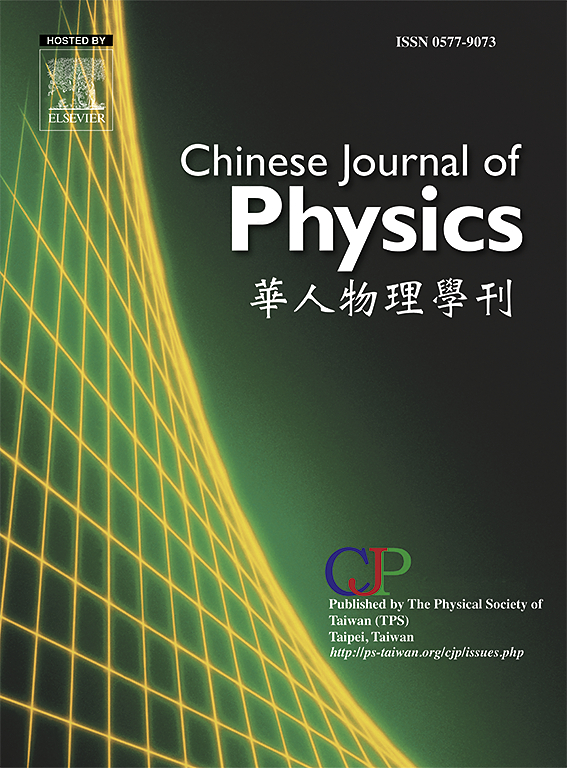Dark matter admixed relativistic stars: Structural properties and tidal Love numbers
IF 4.6
2区 物理与天体物理
Q1 PHYSICS, MULTIDISCIPLINARY
引用次数: 0
Abstract
We study the impact of bosonic, self-interacting dark matter on structural properties and tidal deformabilities of compact stars. As far as the gravitational theory is concerned, we assume Einstein’s gravity in four dimensions with a vanishing cosmological constant. Regarding matter content, we consider a state-of-matter to a linear form of equation-of-state (EoS), while for dark matter we assume a quartic scalar potential, which implies a certain non-linear EoS obtained long time ago. Adopting the two-fluid formalism we integrate the structure equations as well as the Riccati equation for the metric even perturbations imposing appropriate initial conditions at the center of the stars and matching conditions at their surface. We compute the stellar mass and radius, factor of compactness and dimensionless deformability varying several free parameters of the model studied here. Tidal deformability and the corresponding tidal Love number determine the imprint of the underlying EoS within the signals emitted during binary coalescences, and it is expected to be altered due to the presence of dark matter inside the objects. We find that in all cases considered here, the dimensionless deformability of the canonical stellar mass remains lower than the upper bound, . We also look at the stability of these stars based on the Harrison–Zeldovich-Novikov criterion under various conditions. It is observed that the presence of dark matter implies significantly lower highest stellar mass, and also smaller and more compact stars for a given stellar mass.
暗物质混合相对论恒星:结构特性和潮汐爱数
我们研究了玻色子自相互作用暗物质对致密恒星结构特性和潮汐变形能力的影响。就引力理论而言,我们假设爱因斯坦的引力在四维空间中具有消失的宇宙常数。对于物质含量,我们认为物质的状态是一种线性形式的状态方程(EoS),而对于暗物质,我们假设一个四次标量势,这意味着很久以前就得到了某种非线性的EoS。我们采用双流体的形式对结构方程和Riccati方程进行积分,在恒星中心施加适当的初始条件,在恒星表面施加匹配的条件。我们计算了该模型的质量和半径、紧致系数和无量纲可变形性。潮汐的可变形性和相应的潮汐洛夫数决定了在双星合并期间发出的信号中潜在的EoS的印记,并且由于物体内部暗物质的存在,它预计会被改变。我们发现,在这里考虑的所有情况下,标准恒星质量的无量纲可变形性仍然低于上限Λ1.4<800。我们还根据哈里森-泽尔多维奇-诺维科夫准则来观察这些恒星在各种条件下的稳定性。据观察,暗物质的存在意味着恒星的最高质量明显较低,并且对于给定的恒星质量,恒星也更小、更致密。
本文章由计算机程序翻译,如有差异,请以英文原文为准。
求助全文
约1分钟内获得全文
求助全文
来源期刊

Chinese Journal of Physics
物理-物理:综合
CiteScore
8.50
自引率
10.00%
发文量
361
审稿时长
44 days
期刊介绍:
The Chinese Journal of Physics publishes important advances in various branches in physics, including statistical and biophysical physics, condensed matter physics, atomic/molecular physics, optics, particle physics and nuclear physics.
The editors welcome manuscripts on:
-General Physics: Statistical and Quantum Mechanics, etc.-
Gravitation and Astrophysics-
Elementary Particles and Fields-
Nuclear Physics-
Atomic, Molecular, and Optical Physics-
Quantum Information and Quantum Computation-
Fluid Dynamics, Nonlinear Dynamics, Chaos, and Complex Networks-
Plasma and Beam Physics-
Condensed Matter: Structure, etc.-
Condensed Matter: Electronic Properties, etc.-
Polymer, Soft Matter, Biological, and Interdisciplinary Physics.
CJP publishes regular research papers, feature articles and review papers.
 求助内容:
求助内容: 应助结果提醒方式:
应助结果提醒方式:


